Abstract
This paper deals with the issue of increasing the quality and sustainability of education at universities regarding the requirements of employers. Employers’ expectations of university graduates in terms of soft skills are analysed and outlined. The employers participating in this study answered a questionnaire survey focused on understanding university graduates’ soft skills. The collected results were subjected to the method of mathematical–statistical analysis by nonparametric testing of significance of the mean value difference. The significance of the difference for individual skills was confirmed, demonstrating that the surveyed enterprises required and anticipated a level of soft skills development on the part of recent graduates that was insufficient. This finding implies the necessity of improving university education to match the expected and real state of soft skill mastery.
1. Introduction
In a world increasingly saturated with technology, the labour market requires a person wishing to be successful to master mental skills and knowledge. Therefore, to achieve this aim, the educational systems should focus on developing graduates’ interpersonal and creative skills. In future workplaces, machines can be expected to occupy and replace numerous work tasks; thus humans will establish themselves thanks to their soft skills, that is, their artistic and creative skills and abilities.
According to Majid [1], in today’s business world, more and more complexities and competitiveness are appearing. Human resources are generally considered as the critical asset, playing a critical role in organizational performance and success. At present, employers demand from their employees a quality combination of hard and soft skills in addition to knowledge and talents, and often rely on discipline. In a person’s working career, they consider whether their level of hard and soft skills is appropriate. Employers know that professional and technical skills alone cannot help achieve organizational goals and maintain company competitiveness [1].
Contemporary job seekers face many challenges in the present competitive labour market. Some authors [2,3,4] suggest that organizations consider human assets critical to their success and usually make meticulous efforts to hire the best candidate. The qualities preferred for such candidates include technical knowledge within the field or the position as well as soft skills. Many employers can see that in order for the company to achieve its goals, the employees must master the technical and professional knowledge and superstructure of soft skills. This means that soft skills are becoming critical to the success of a company.
Concerning the applicability of graduates, Tran [5] states that limitations in skill development during university is considered one of the most significant barriers preventing university graduates from making a smooth transition to the workplace. Moreover, many academic experts and researchers agree that there is an increasing difference between the expected soft skills and the level of skills that graduates possess. According to Majid, different leadership and decision-making processes require different skill proficiencies from newly employed candidates [1].
An interesting analysis was conducted by Showry, demonstrating that some fields such as finance, marketing, and human resources can teach graduates hard skills; however, in order to find the right job, they also need to master soft skills. A perfect blend of technical skills and soft skills is demanded to face unique challenges and move ahead. Google’s hiring algorithms show the following list of soft skills taking the top seven out of eight places: communication, listening, being a good coach, open-mindedness, critical thinking, problem-solving, empathy, and creativity [6]. Thus, this finding suggests that academic programs should give these skills sufficient attention and design practical tools and methods for graduates to employ and apply the learned skills to enhance their professional careers.
Another area of soft skill competence in companies is ethical responsibility, which needs to be defined concerning employees, stakeholders, and the environment. It will be necessary to develop and create new descriptors and approaches to soft skills to be implemented, mainly through CSR. The participatory role of applied ethics, ethical advice, and ethical expertise should be compatible both with such requirements and a new mission. According to Vázquez-Carrasco and Lopez-Peréz’s [7] research, small and medium-sized enterprises are unique, making general assumptions applicable to other types of firms of little use. Corporate Social Responsibility (CSR) is no exception. Recent decades have seen many studies that debate definitions, consider content and scope, and study causal relationships with antecedents and implications for the application of CSR. According to Habek and Wolniak [8], organizations may communicate their sustainability engagement and present results achieved in this field by creating and publishing corporate social responsibility (CSR) reports. These authors state that we can presently observe a growing number of companies issuing such reports as a part of their annual reports or as stand-alone CSR reports. Despite the increase in the number of such reports, their quality is variable [8]. The results of Cheng indicate that individual age, job experience, and administrative region will have significant effects on unethical behaviour. In addition, a consideration of the interaction between organizational scale and age shows that scale has the potential to incite unethical behaviour among salespeople [9].
The aim of the article is to present the results of the authors’ long-term research, which is focused on a comprehensive and systematic analysis of soft skills in the context of the analysis of skills required by employers from graduates of technical universities. In the research, we used the method of mathematical–statistical analysis by nonparametric testing to test the null hypothesis that there are no significant differences between expectations and the actual situation.
2. Literature Review
At the Conarc Soft Skills Training Conference in 1972, Whitmore explained the term “soft skills” (in the areas of command, supervision, consultancy, and management) for the first time. He conducted a questionnaire survey and came to the definition of the term: “soft skills are important job-related skills that involve little or no interaction with machines and whose application in the workplace is generalized” [10]. Despite some discussions of the term, in 1972, psychologist Nicholas Humphrey claimed that social intelligence describes people more precisely than quantitative intelligence. The dominance of social characterization of people was also confirmed by everyday life, where soft skills outperform quantitative skills in different contexts. The term started to exist formally and globally in 1972.
The Collins English Dictionary defines the term soft skills as “desirable qualities for certain forms of employment that do not depend on acquired knowledge: they include common sense, the ability to deal with people, and a positive, flexible attitude.” Parsons considers soft skills to be character traits, attitudes, and behaviours that enhance a person’s interactions, job performance, as opposed to technical aptitude or knowledge. They are the intangible, non-technical, personality-specific skills that characterize a person as a leader, facilitator, mediator, and negotiator. The development of soft skills is not limited by profession. They are constantly developing and naturally improving in personal and professional everyday life [11]. Goleman distinguishes between hard skills and soft skills. The former are about the ability to conduct a particular type of task or activity. In contrast, the later relates to a person’s relationships with others and can be applied widely [11].
The importance of soft skills that include emotional intelligence in finding or maintaining employment is supported by Goleman’s research [12]. Based on research on 181 positions in 121 organizations, he found that emotional intelligence makes up 67% of all qualities needed to succeed in getting the right job. The percentage of work done using emotional intelligence is twice as significant as that done using the intelligence quotient. Similar research was conducted by Holtom and Bowen [13]; they came to the same conclusions after investigating 40 enterprises.
The definition of emotional intelligence is often discussed by experts in the sense of which term is superior to which, and they are all partially correct. However, we may say that soft skills are superior to emotional intelligence, as the account of soft skills is more complex than the account of characteristics making up emotional intelligence. Mühleisen and Oberhuber [14] suggest that effective communication requires the skills of empathy, ability to persuade, ability to negotiate, teamwork, and ability to work with others. Another definition of soft skills is presented by Moss and Tilly [15], who see soft skills as abilities relating to personality and behaviours which lie beyond technical and formal knowledge. Murti [16] looks at soft skills through the results they bring rather than methods or techniques, e.g., statistical analysis. They include communication, interpersonal relationships, conflict resolution, team building, negotiation, and presentation. According to Ackerman, emotional intelligence also includes social competence, which is made up of communication ability, the ability to build relationships in an emotionally correct process. Human interactions have become an essential part of customer-oriented contemporary businesses and services; therefore, soft skills, namely empathy, communication, and problem-solving, need to gain principal attention [17]. Wellington used his career experiences to describe the skills of successful managers. He had worked in different managerial positions, mainly in human resources. He noticed that the great technical skills which make for successful managers were supported by soft skills based on excellent teamwork, positive attitude, and willingness to work with others [18]. Based on previous definitions, soft skills can be described as non-technical socially and interpersonally interactive competencies which correlate with emotional (EQ) and social intelligence, and which coincide with each other and affect recruitment significantly. Klaus’ research shows that companies value the interpersonal skills of their employees more than analytical abilities. He points out that while hard skills are essential to win an interview, an applicant needs soft skills to maintain the job. A successful career requires not only knowledge but also a method for how to convey it [19].
Many kinds of research have been performed on the next century’s needs. It shows that applicants possessing excellent interpersonal skills are most likely to be hired [4,20,21,22,23]; however, the new graduates do not meet expected standards [24]. Evenson [25] states that employers recommend that teachers should teach how to cooperate with others and focus on acquiring customer communication skills. Sutton [26] thinks that soft skills are ranked as number one, and are extremely important for job applicants in many positions across various industries. Hiring applicants who have interpersonal skills presents a competitive advantage in maintaining a successful organization [27]. Soft skills are not critical in manual or technical positions [28]; however, managerial posts value them highly [29].
In its Future of Jobs Report, the World Economic Forum (WEF) [30] looked at current employment, skills, and workforce strategies to identify the top ten skills everyone will need in the fourth industrial revolution. The report compares the shift in the soft skills needed to succeed in maintaining a job. The top ten soft skills in 2020 are complex problem solving, critical thinking, creativity, people management, coordinating with others, emotional intelligence, judgment and decision making, service orientation, negotiation, and cognitive flexibility (Figure 1).
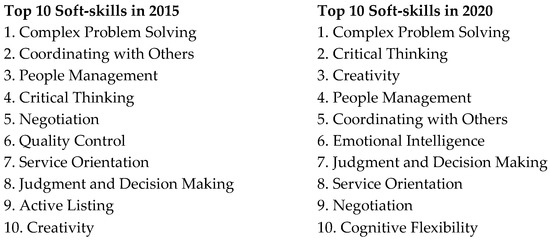
Figure 1.
Comparison of top ten soft skills in 2015 and 2020, according to the WEF report. Original image source: World Economic Forum [30].
A study performed by Workday in the US [31] contacted 100 academic institutions and 100 corporations in the USA. Based on their responses, it was found that newly hired applicants lack the soft skills to function well in the occupational context, despite some progress in mastering the skills. In addition, preparing students thoroughly or reskilling of existing workers is hindered by non-existent or minimal close and detailed cooperation between academic institutions and business entities. Moreover, budget restrictions and planning are also slowing this process. Only 35 percent of corporations feel that recruits and students are well prepared with hard and soft skills to perform at a high level in professional life. The same study also states that “the lack of good communication, collaboration, and conflict resolution skills are holding people back.” Workday presented the results of their joint study with Bloomberg’s Next. They found that a surprising four in ten corporations, and almost half of surveyed academic institutions, believe new hires lack the soft skills required to perform at a high level. The research found that 69 percent of corporate respondents and 88 percent of academic respondents thought their fresh recruits and students could master hard skills. However, speaking of soft skills, roughly 40 percent of corporations and nearly 50 percent of academic institutions saw the inability of graduates to use soft skills at a high level in their job tasks. They also mentioned the research of West Monroe Partners, which shows that 98% of human resources (HR) leaders believe soft skills are essential for hiring candidates into technology roles [31].
Murti states that the idea of soft skills as a prerequisite for business success is not a new one. He states that soft skills are an essential part of any job. Despite this, soft skills appear to be challenging to teach and even harder to evaluate in the classroom. Personal attributes, attitudes towards work, and individual qualities are complicated to evaluate, and thus, in practice, proxies are used. Soft skills are hard to assess, and are developed through relationships long before any formal education [16].
Garofalo et al. provide recommendations for improving the skills of job seekers. They turn their attention primarily to low- and middle-skilled workers looking to build their skills and abilities. Because recent changes in the labour market and the needs of employers affect these workers the most, and possibly very unfavourably, they should be included in life-long learning in order to be able to respond to the new needs of employers. Therefore, life-long education remains an essential measure to prepare for other work possibilities, possibly in different fields. Policymakers should prepare other ways and incentives to retrain or reskill those workers who have become redundant due to lack of relevant skills [32].
There are other challenges in soft skills education; as Holtom and Bowen [13] relate, academic institutions need to find better methods to teach soft skills and to assess progress in mastering them. Both processes still do not seem to have practical solutions. Onisk [33] found that the outcomes of soft skills training are often intangible, and provide gradual or deferred returns.
Mitchel et al. [4] recommend that the development of higher education should be designed to help integrate interpersonal skills into business curricula. The soft skills included in the business curricula are those which ranked low, and thus are likely to be missing in the labour market. On the other hand, there is an assumption that academic institutions do not integrate those skills into the business curriculum. Another aspect of the inclusion of soft skills in business curricula is that not every student is necessarily suited to acquiring soft skills due to different individual learning styles. The topic of individual learning styles was developed by Boyce et al., who recommend using case studies as an instructional method in order to address students’ varied learning styles and choose the best learning theory framework, which is crucial to teaching and learning soft skills [34].
3. Research Design
The aim of this research was to assess which skills businesses required from graduates of two Slovak technical universities in the years 2018–2019 [35]. We specified the following five areas of soft skills: Creative thinking, Cooperation or teamwork, Time management, Communication, and Assertiveness. Those skills were further analysed in terms of skills possessed by technical university graduates.
A questionnaire is a research method commonly used to assess attitudes and opinions. Therefore, it was used in this research to assess the expected and perceived skills of graduates. The survey was applied to two target groups: respondents from companies who described university graduates from the point of view of their expected or required competencies and the actual state of those competencies, and current university students, who subjectively described their knowledge in the same specified areas. The exact procedure of the questionnaire design, the Likert scale assessment, and the respondents’ analysis are described in detail in the scientific monograph focusing on the full-scale research [35].
Individual areas of soft skills were evaluated with Likert scale questions. The scale options are shown in Table 1. The questionnaire consisted of questions with five scale options to choose from. In each question, only one option, represented by a particular value, could be chosen for each question.

Table 1.
Likert scale of evaluation.
The questionnaire was sent to 200 employees working in enterprises operating in the Slovak Republic. One hundred fifty-five respondents responded to the questionnaire, which accounts for a 77.5% return rate. The respondents in this group were divided by size into small enterprises employing fewer than 50 people (38%), medium-size enterprises employing 50–249 people (27%), and large enterprises with more than 250 people accounting for 35%. The student group comprised a total of 132 students, and achieved a 100% return. A deeper analysis of this group showed 55% of students were pursuing a bachelor’s degree, while 45% were master’s degree students.
The data obtained from the questionnaires were statistically processed using several mathematical inductive methods. First, normal distribution was tested, followed by the Shapiro–Wilk test. We assumed that nonparametric variables exhibited a normal distribution. After that, we used a statistical induction method with the Mann–Whitney U test for nonparametric tests to verify the significance of the difference between the expected and actual state of competencies.
The data obtained from the questionnaires were first tested for normal distribution to select a suitable method of mathematical induction. The Shapiro–Wilk test was chosen from the many tests that statistical software currently provides. The assumption that our research outputs were nonparametric variables that did not exhibit a normal distribution was verified. Subsequently, nonparametric testing using statistical induction methods, namely the Mann–Whitney U test, was used to investigate the significance of the difference between the expected and actual state of competencies.
4. Results and Research Evaluation
The processing of questionnaire survey data consisted of several consequent steps. First, two databases of the survey were created. The first database of employees from enterprises, comprising 155 respondents, evaluated the expected and actual state of soft skills mastered by university graduates. The other group consisted of 132 students from technical universities, who evaluated statements regarding their university education in soft skills. The collected questionnaires from both databases were further processed by statistical and mathematical calculations.
STATISTICA (VERSION10) software was used to conduct statistical processing of the data. First, we examined the normality of the distribution using the Shapiro–Wilk test. As this test confirmed the non-normal distribution of the variables, and the data were ordinal, it was followed by mathematical–statistical analysis using the Mann–Whitney U test to find the significance of the mean difference. All tests were calculated with a significance level of α = 5%; the calculation results are given in the tables. The results of individual tests are represented as radar charts or box plots. A detailed description of the whole statistical processing can be found in Sujová et al. [35].
4.1. Competency Assessment by Employees from Business Enterprises
The questionnaire survey covered five different soft skills. The respondents from enterprises expressed their opinions on their expectations and the actual state of the skills as perceived in their newly hired employees. The following section describes the procedure of the assessment. Communication competence was chosen as an example of the procedure for processing individual soft skills. The analysis of the Communication skill of the selected soft skills is presented in the description of the assessment procedure.
In the first step, descriptive statistics parameters were evaluated; analysis of mathematical statistics relating to the Communication skill responses to the enterprise questionnaires was then performed. The null hypothesis, that there were no significant differences between expectations and the actual state, was tested. Using the same procedure, we analysed all selected soft skills in our research. Table 2 presents the results of the questionnaires, with the statements and Likert scale options. The table shows absolute frequencies and relative frequencies for both states, expected and actual, with the Communication skill as an example.

Table 2.
Descriptive statistics parameters for Communication.
A comparison of the expected and the actual states of the relative frequencies for Communication leads us to conclude that there are considerable differences between ratings. To confirm the hypothesis about the significance of the difference between the practical expectations and actual knowledge of graduates, the Mann–Whitney U test was used to test our results.
The results of the test of the significance of the differences between the expected and actual states of students’ soft skills by their employers are given in Table 3.

Table 3.
The Mann–Whitney U test results for the Communication skill, as assessed by employees from enterprises.
We rejected the null hypothesis by these test results based on the p-value (p = 0.014). When the null hypothesis was rejected, we inclined to the alternative hypothesis, namely that a significant difference exists between the expected and actual state of soft skills. Figure 2 presents a box plot for the Communication skill illustrating the results on the expected and actual state of this skill.
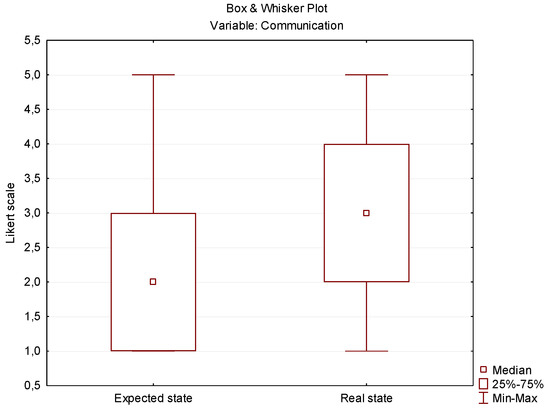
Figure 2.
Communication skill as assessed by enterprises, comparing the expected and actual state of the skill.
4.2. Comparison of Soft Skills: Student Responses vs. Enterprise Responses
Similar to the previous analysis of soft skills, we chose statistical testing for nonparametric variables of both student responses and enterprise responses. Table 4 summarises the results of the tests of all data retrieved from questionnaires.

Table 4.
The individual soft skills results by the Mann–Whitney U test.
Because the p-value was p = 0.005, and also because of the other result of the Mann–Whitney U test, we rejected the null hypothesis. This result led us to accept the alternative hypothesis, that some soft skills show a statistically significant difference in how students and enterprises see four out of the five soft skills, namely Creative Thinking, Teamwork, Time Management, and Communication.
The only skill where a statistically significant difference was not confirmed was Assertiveness; it can be said that the two groups of respondents see this skill in the same way.
The results given in Table 4 show the areas where there was a statistically significant difference between the respective view of soft skills by students and employees from enterprises. The box plots shown in the next section depict the test results on the significance of the difference for the confirmed areas of Creative Thinking, Teamwork, Communication, and Time Management.
Considering the results shown in Figure 3, Figure 4, Figure 5 and Figure 6, it can be concluded that students see their skills more positively than the same skill levels as seen by the enterprises. This conclusion means that students assess themselves more positively than the reality as assessed by employers in enterprises when assessing the skills of newly hired graduates.
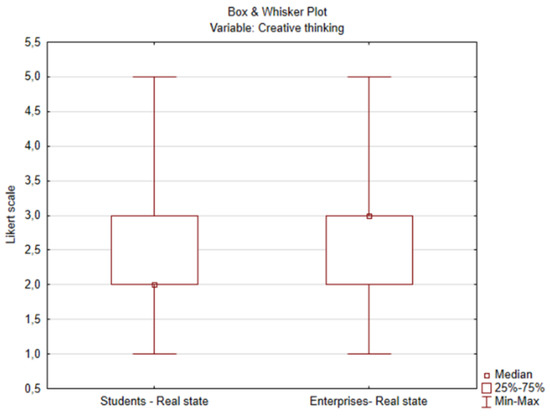
Figure 3.
Box plot for Creative thinking—students vs. enterprises.
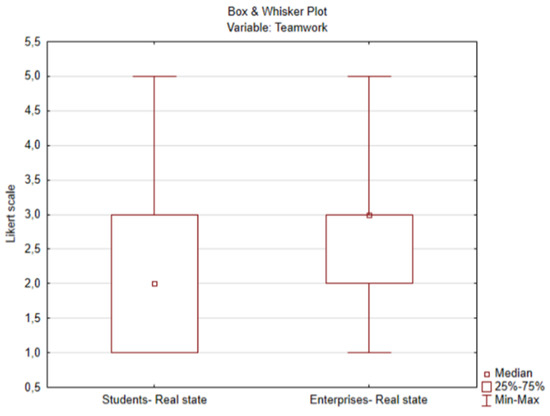
Figure 4.
Box plot for Teamwork—students vs. enterprises.
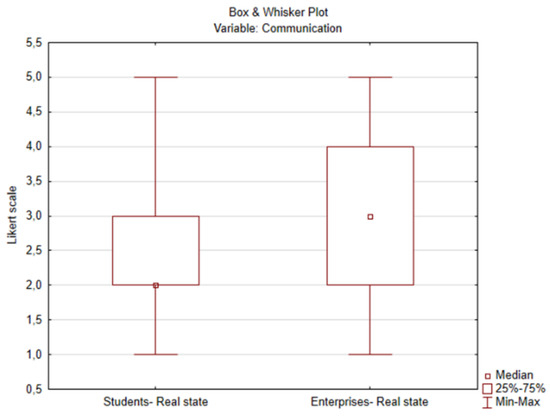
Figure 5.
Box plot for Communication—students vs. enterprises.
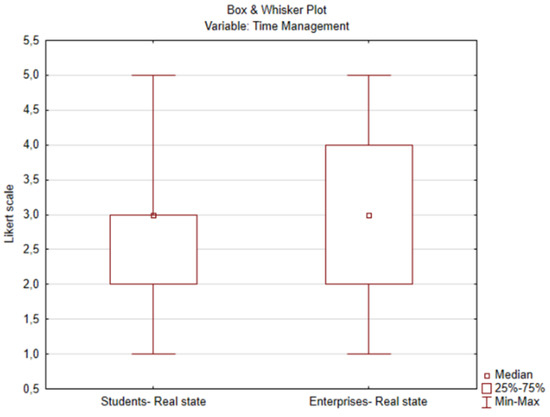
Figure 6.
Box plot for Time management—students vs. enterprises.
These results suggest that the skills required in the practice of businesses are not being achieved; thus, the academic preparation of students needs to focus more on the effective teaching of these skills. Such measures would harmonize the actual needs of enterprises with the skills mastered by graduates available for hiring.
4.3. Proposal for Improvement of Measures
To improve the quality of education in the soft skills of graduates of production process management programmes at technical universities, we propose a design for a competency model and consequent implementation of soft skills training into an academic curriculum. The competence model was created based on the analysis of enterprise requests for soft skills. There were eight soft skills suggested in the questionnaire, and Table 5 shows the medians of the individual skills. To create the competency model, the first five were chosen: Creative Thinking, Teamwork, Time management, Communication, and Assertiveness. Assertiveness is a soft skill that was required to be well-developed, and there was also a similarity in the views of students and enterprises with respect to this skill. However, it was included in the competence model because it is among the skills required by enterprises. Figure 7 presents the design of a competency model for selected soft-skills. The model shows a complex of soft-skills competencies that should be given increased attention in university education based on the requirements of companies.

Table 5.
Enterprise expectations of soft skills, given in medians.
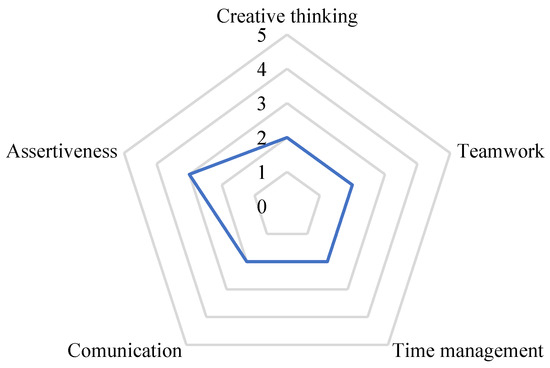
Figure 7.
Soft skills competence model.
The other measure presents the introduction of training activities in study programs in enterprise management at technical universities. The list of soft skills required by enterprises needs to include Stress Resistance as a skill requiring very high development, as shown in Table 5, which is why this skill was prioritized against Assertiveness and included in the pool of skills that need to be taught at universities in specially designed training courses. This should secure a well-balanced graduate profile matching the requirements from enterprises in the labour market.
5. Discussion
Soft skills are in great demand by employers today and their development should be considered a good investment by enterprises. Although interpersonal skills are crucial for employers, many job seekers and current employees do not have adequate interpersonal skills [24]. The role of modern organizations is to train their employees to improve their soft skills. We assume that in accordance with these findings [20,27], graduates with developed soft skills have a competitive advantage in recruitment and more easily perform job tasks in lower management positions. For these reasons, it is the role of universities to prepare students for the requirements of practice. There are many challenges in doing so, as well as many opportunities in university education to prepare students for today’s workforce. Educators need to understand the importance of interpersonal skills and incorporate soft skills into their curricula. Instructional strategies and methods can be used in the classroom to enhance interpersonal skills. Soft skills and hard skills should be integrated to create a well-educated graduate.
In the constantly changing market, there is a contract between academic preparation and practical life in enterprises where employers are starting to appreciate and look for new skills and abilities from their employees, including university graduates, as evidenced by the cited scientific works [23]. The conclusions of several studies [4,34] recommend including the teaching and practice of tasks focused on soft skills in the curriculum. However, universities have always intended to educate and develop not only knowledge, but also skills and personal abilities. At the same time, university educators need to reflect on the social requirements for expertise and professional skills in the different sectors of the economy. On the other hand, university education has changed and transformed operational processes fundamentally over the past several decades. One transformative tool is the research conducted at universities to come up with new findings.
Our research points to the need to apply soft skills training to the curriculum for technically-oriented study programs in response to the requirements of employers, as confirmed by other research [6,16,31].
The conclusions and future implications of the research conducted in this study are focused on soft skills as perceived by students and enterprises on the need for and mastering of soft skills by employees and graduates. The primary data source in the research was the questionnaire sent to two groups of respondents, students and enterprises. Students expressed their understanding of individual soft skills. The enterprises evaluated their expectations concerning mastery of soft skills and experience of the actual state of those skills in their company. The data collected from the questionnaire were analysed by mathematical and statistical tests. The statistical significance of the differences was tested using the Mann–Whitney U test. This test confirmed the assumption that there is a difference between the students and enterprises when it comes to their views on soft skills proficiency. The enterprises generally had higher expectations than the graduates. Our research resulted in a proposal for a competency model to address the finding that graduates’ soft skills are not achieving the state required by enterprises. The competency model presents an original design relating to skills where universities need to expand their instructional activities. However, the proposed competency model requires further professional and academic discussion and verification, as the research was conducted within two technical universities and a limited number of enterprises. Nevertheless, the competency model we propose is the beginning of developing a model for universities in communication with enterprises. The findings of the present research suggest that education needs to include specific soft skills in the university curriculum of management programs so that the actual knowledge of students is in balance with the requirements of employers.
Based on our the research findings, the following proposals for improving the quality of education in study programs aimed at managing production processes are presented:
- To improve competencies in soft skills such as Creative Thinking, Time Management, Resistance to Stress, and Communication, development of these skills should be included in teaching activities aimed at their practical application. The Communication area is a crucial skill and has great potential for improvement through targeted graduate work activities.
- Implementing skill-focused educational activities presents a critical and highly desirable need. As it is a vital requirement of businesses in their practice, it should be reflected in the curriculum of universities trying to respond to the practical needs of the labour market, and should also fulfil the aim of developing university graduates’ range of knowledge and skills. Specifically, adding particular soft skills to study programs seems critical for the thorough and complex preparation of students.
In conclusion, this research and its results are a textbook example of the collaboration between theory (university) and practice (enterprise). Such cooperation can only improve the way both sides function in society and interact with each other.
As today’s labour market is becoming a global place, it is a challenge for universities to equip graduates with the skills which enable them to place themselves and function successfully anywhere in a domestic or multinational market. Our research into the need for and practice of soft skills and the corresponding situation in the academic world presents possible solutions for further improvement of universities in finding what is wanted in practice and ways to meet this challenging task. In the results and conclusions of our research, we perceive a contribution to the sustainability of education. This contribution consists mainly in the application of the soft skills competence model to the syllabi of university study programs, which will meet the expectations and requirements of companies in terms of the competence of university graduates. The limitations of this study mainly lie in the area of regional sampling. In subsequent research, the authors of this article intend to focus on further extending the field of sampling to the V4 countries.
Author Contributions
Conceptualization, E.S. and H.Č.; methodology, E.S.; validation, Ľ.S., and P.G.; investigation, E.S.; H.Č.; Ľ.S. and P.G.; resources, E.S. and Ľ.S.; data curation, P.G.; writing—original draft preparation, E.S.; writing—review and editing J.Š.; project administration, H.Č.; funding acquisition, H.Č. All authors have read and agreed to the published version of the manuscript.
Funding
APPV-17-0400 Enhancing the Ethical Environment in Slovakia (Institutional Procedures, Actors, Risks, Strategies).
Institutional Review Board Statement
This study was omitted from ethical review and approval due to the anonymity of the respondents. By completing the questionnaire, the respondents gave informed consent to the anonymous processing of their opinions.
Informed Consent Statement
Informed consent was obtained from all entities involved in the soft-skills opinion survey.
Data Availability Statement
All subjects gave their informed consent to inclusion prior to participation in the study. The study was conducted in accordance with the Declaration of Helsinki and the research was conducted in accordance with the Code of Ethics of the Technical University of Zvolen.
Acknowledgments
The authors would like to acknowledge the Agency APPV for supporting the APPV-17-0400 project “Enhancing the Ethical Environment in Slovakia (Institutional Procedures, Actors, Risks, Strategies)”. This article was created as a part of the project. This publication is the result of the implementation of the project “Progressive Research into Utility Properties of Materials and Products Based on Wood (LignoPro)”, ITMS 313011T720 supported by the Operational Programme Integrated Infrastructure (OPII) funded by the ERDF.
Conflicts of Interest
The authors declare no conflict of interest.
References
- Majid, S.; Liming, Z.; Tong, S.; Raihana, S. Importance of Soft Skills for Education and Career Success. Int. J. Cross-Discip. Subj. Educ. 2012, 2, 1036–1042. [Google Scholar] [CrossRef]
- Hąbek, P.; Lavios, J.J. Analysis of Sustainable Production Practices Implemented by Car Manufacturers. Multidiscip. Asp. Prod. Eng. 2018, 1, 837–843. [Google Scholar] [CrossRef][Green Version]
- Hitka, M.; Lorincová, S. Organization of Managerial Work; Technical University in Zvolen: Zvolen, Slovak Republic, 2016; ISBN 978-80-228-2856-7. [Google Scholar]
- Mitchell, G.W.; Skinner, L.B.; White, B.J. Essential soft skills for success in the twenty-first century workforce as perceived by business educators. Delta Pi Epsil. J. 2010, 52, 43–53. [Google Scholar]
- Tran, T.T. Limitation on the development of skills in higher education in Vietnam. High Educ. 2013, 65, 631–644. [Google Scholar] [CrossRef]
- Showry, M. Focus on soft skills. IUP J. Soft Ski. 2019, 13, 6. [Google Scholar]
- Vázquez-Carrasco, R.; López-Pérez, M.E. Small & medium-sized enterprises and Corporate Social Responsibility: A systematic review of the literature. Qual. Quant. 2013, 47, 3205–3218. [Google Scholar] [CrossRef]
- Hąbek, P.; Wolniak, R. Assessing the quality of corporate social responsibility reports: The case of reporting practices in selected European Union member states. Qual. Quant. 2016, 50, 399–420. [Google Scholar] [CrossRef] [PubMed]
- Cheng, C.; Hsieh, C.; Yang, Y. Who would engage in unethical behavior? Should organizations bear the responsibility? Qual. Quant. 2014, 48, 2341–2354. [Google Scholar] [CrossRef]
- Conarc Soft Skills Training Conference. Available online: https://apps.dtic.mil/dtic/tr/fulltext/u2/a099612.pdf (accessed on 21 April 2020).
- Parsons, T.L. Definition Soft Skills. Available online: http://searchcio.techtarget.com/definition/soft-skills (accessed on 30 June 2018).
- Goleman, D. Working with Emotional Intelligence: [How to Start a Successful Career]; Bantam Books: New York, NY, USA, 2000. [Google Scholar]
- Holtom, D.; Bowen, R. People and Work Unit: Evaluation of the Equal Development Partnership ‘Valuing Learning—Strengthening Communities’ Project. Available online: http://www.equal-works.com/resources/contentfiles/2447.pdf (accessed on 24 August 2021).
- Mühleisen, S.; Oberhuber, N. Communication and Other Soft Skills; Grada: Prague, Czech Republic, 2008. [Google Scholar]
- Moss, P.; Tilly, C.H. Soft Skills and Race: An Investigation of Black Men’s Employment Problems. Work. Occup. 1996, 23, 252–276. [Google Scholar] [CrossRef]
- Murti, A.S. Why Soft Skills Matter. IUP J. Soft Ski. 2014, 8, 32–36. [Google Scholar]
- Ackerman, C.E. How to Improve Emotional Intelligence in the Workplace. Posit. Psychol. 2020. Available online: https://positivepsychology.com/emotional-intelligence-workplace/ (accessed on 27 May 2020).
- Wellington, J.K. The “soft skills” of success: Be it high tech, low tech, or no tech. Vital Speeches Day 2005, 71, 628. [Google Scholar]
- Klaus, P. Communication breakdown. Calif. Job J. 2010, 28, 1–9. [Google Scholar]
- Fiori, M. A new look at emotional intelligence: A dual–process framework. Personal. Soc. Psychol. Rev. 2009, 13, 21–44. [Google Scholar] [CrossRef] [PubMed]
- Perreault, H. Business educators can take a leadership role in character education. Bus. Educ. Forum 2004, 59, 23–24. [Google Scholar]
- Nicolaides, C. Focus on Soft Skills: A Leadership Wake-up Call. Available online: http://www.businessknowhow.com/growth/softskills.htm (accessed on 5 May 2020).
- Wilhelm, W.J. Determinants of moral reasoning: Academic factors, gender, richness of life experiences, and religious preferences. Delta Pi Epsil. J. 2004, 46, 105–121. [Google Scholar]
- Working towards Your Future: Making the Most of Your Time in Higher Education. Available online: http://www.nus.org.uk/en/news/news/your-guideto-better-employability-skills/ (accessed on 30 April 2020).
- Evenson, R. Soft skills, hard sell. Tech. Mak. Educ. Career Connect. 1999, 74, 29–31. [Google Scholar]
- Sutton, N. Why can’t we all just get along? Comput. Can. 2002, 28, 20. [Google Scholar]
- Glenn, J.L. The “new” customer service model: Customer advocate, company ambassador. Bus. Educ. Forum 2008, 62, 7–13. [Google Scholar]
- James, R.F.; James, M.L. Teaching career and technical skills in a “mini” business world. Bus. Educ. Forum 2004, 59, 39–41. [Google Scholar]
- John, J. Study on the Nature of Impact of Soft Skills Training Programme on the Soft Skills Development of Management Students. Available online: https://www.semanticscholar.org/paper/Study-on-the-Nature-of-Impact-of-Soft-Skills-on-the-John/adac40698a562affacfaf9b7cbb6abed23e51321?sort=relevance&citationIntent=result (accessed on 10 November 2021).
- The Future of Jobs 2016. Available online: http://www3.weforum.org/docs/WEF_Future_of_Jobs.pdf (accessed on 7 April 2020).
- Workday Inc.: Next Study Reveals Need for Greater Collaboration Between Academia and Business to Close the Skills Gap. Available online: https://www.globenewswire.com/news-release/2018/06/28/1531112/0/en/Workday-and-Bloomberg-Next-Study-Reveals-Need-for-Greater-Collaboration-Between-Academia-and-Business-to-Close-the-Skills-Gap.html (accessed on 16 April 2020).
- Garofalo, A.; Castellano, R.; Punzo, G. Skills and labour incomes: How unequal is Italy as part of the Southern European countries? Qual. Quant. 2018, 52, 1471–1500. [Google Scholar] [CrossRef]
- Onisk, M. Is Measuring Soft-skills Training Really Possible? Appcon: Sidney, Australia, 2011. [Google Scholar]
- Boyce, G.; Williams, S.; Kelly, A.; Yee, H. Fostering deep and elaborative learning and generic (soft) skill development: The strategic use of case studies in accounting education. Account. Educ. 2001, 10, 37–60. [Google Scholar] [CrossRef]
- Sujová, E.; Čierna, H.; Simanová, Ľ.; Gejdoš, P. Soft-Skills Integration into Production Processes. Scientific Monograph; PANOVA S.A: Gliwice, Poland, 2019. [Google Scholar]
Publisher’s Note: MDPI stays neutral with regard to jurisdictional claims in published maps and institutional affiliations. |
© 2021 by the authors. Licensee MDPI, Basel, Switzerland. This article is an open access article distributed under the terms and conditions of the Creative Commons Attribution (CC BY) license (https://creativecommons.org/licenses/by/4.0/).